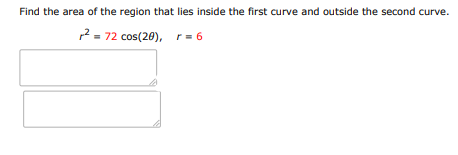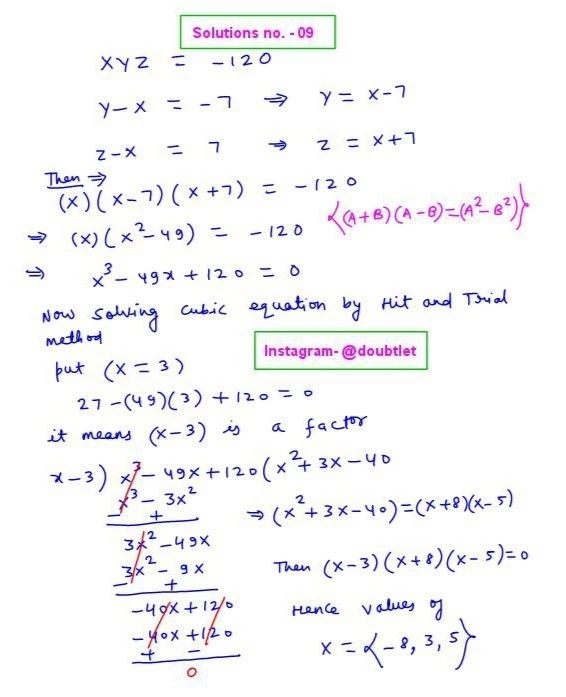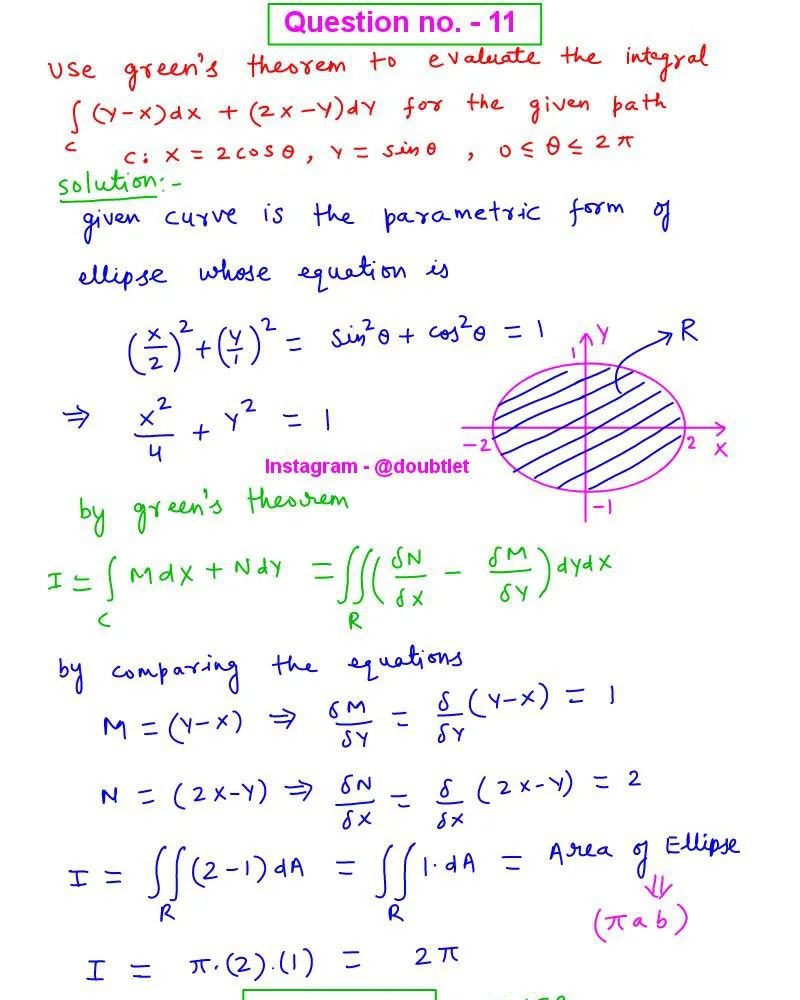Neetesh Kumar | January 1, 2025
Calculus Homework Help
This is the solution to Math 1c Assignment: 10.4 Question Number 8 Contact me if you need help with Homework, Assignments, Tutoring Sessions, or Exams for STEM subjects. Testimonials or Vouches from here of the previous works I have done.
Get Homework Help
Step-by-step solution:
To calculate the area of the region inside the first curve r 2 = 72 cos ( 2 θ ) r^2 = 72 \cos(2\theta) r 2 = 72 cos ( 2 θ ) r = 6 r = 6 r = 6
Step 1: Express the Area Formula:
The area in polar coordinates is given by:
A = 1 2 ∫ θ 1 θ 2 ( r 1 2 − r 2 2 ) d θ A = \frac{1}{2} \int_{\theta_1}^{\theta_2} \left(r_1^2 - r_2^2\right) \, d\theta A = 2 1 ∫ θ 1 θ 2 ( r 1 2 − r 2 2 ) d θ
Here:
r 1 2 r_1^2 r 1 2 r 2 = 72 cos ( 2 θ ) r^2 = 72 \cos(2\theta) r 2 = 72 cos ( 2 θ ) r = 72 cos ( 2 θ ) r = \sqrt{72 \cos(2\theta)} r = 72 cos ( 2 θ ) r 2 r_2 r 2 r = 6 r = 6 r = 6
Step 2: Determine the Limits of Integration:
To find the limits of integration, solve for θ \theta θ
Equating r 2 r^2 r 2 r 2 r^2 r 2
r 2 = 72 cos ( 2 θ ) = 6 2 r^2 = 72 \cos(2\theta) = 6^2 r 2 = 72 cos ( 2 θ ) = 6 2
This simplifies to:
72 cos ( 2 θ ) = 36 72 \cos(2\theta) = 36 72 cos ( 2 θ ) = 36
cos ( 2 θ ) = 1 2 \cos(2\theta) = \frac{1}{2} cos ( 2 θ ) = 2 1
The solutions for cos ( 2 θ ) = 1 2 \cos(2\theta) = \frac{1}{2} cos ( 2 θ ) = 2 1
2 θ = ± π 3 + 2 n π 2\theta = \pm \frac{\pi}{3} + 2n\pi 2 θ = ± 3 π + 2 nπ
θ = ± π 6 + n π \theta = \pm \frac{\pi}{6} + n\pi θ = ± 6 π + nπ
Within one period ( 0 ≤ θ ≤ 2 π ) (0 \leq \theta \leq 2\pi) ( 0 ≤ θ ≤ 2 π )
θ 1 = − π 6 , θ 2 = π 6 \theta_1 = -\frac{\pi}{6}, \quad \theta_2 = \frac{\pi}{6} θ 1 = − 6 π , θ 2 = 6 π
Step 3: Set Up the Integral:
The area is:
A = 1 2 ∫ − π / 6 π / 6 ( r 1 2 − r 2 2 ) d θ A = \frac{1}{2} \int_{-\pi/6}^{\pi/6} \left( r_1^2 - r_2^2 \right) \, d\theta A = 2 1 ∫ − π /6 π /6 ( r 1 2 − r 2 2 ) d θ
Substitute r 1 2 = 72 cos ( 2 θ ) r_1^2 = 72 \cos(2\theta) r 1 2 = 72 cos ( 2 θ ) r 2 2 = 36 r_2^2 = 36 r 2 2 = 36
A = 1 2 ∫ − π / 6 π / 6 ( 72 cos ( 2 θ ) − 36 ) d θ A = \frac{1}{2} \int_{-\pi/6}^{\pi/6} \left( 72 \cos(2\theta) - 36 \right) \, d\theta A = 2 1 ∫ − π /6 π /6 ( 72 cos ( 2 θ ) − 36 ) d θ
Step 4: Simplify the Integral:
Separate the integral into two parts:
A = 1 2 [ ∫ − π / 6 π / 6 72 cos ( 2 θ ) d θ − ∫ − π / 6 π / 6 36 d θ ] A = \frac{1}{2} \left[ \int_{-\pi/6}^{\pi/6} 72 \cos(2\theta) \, d\theta - \int_{-\pi/6}^{\pi/6} 36 \, d\theta \right] A = 2 1 [ ∫ − π /6 π /6 72 cos ( 2 θ ) d θ − ∫ − π /6 π /6 36 d θ ]
Part 1: Evaluate ∫ 72 cos ( 2 θ ) d θ \int 72 \cos(2\theta) \, d\theta ∫ 72 cos ( 2 θ ) d θ
The integral of cos ( 2 θ ) \cos(2\theta) cos ( 2 θ )
∫ cos ( 2 θ ) d θ = 1 2 sin ( 2 θ ) \int \cos(2\theta) \, d\theta = \frac{1}{2} \sin(2\theta) ∫ cos ( 2 θ ) d θ = 2 1 sin ( 2 θ )
Thus:
∫ − π / 6 π / 6 72 cos ( 2 θ ) d θ = 72 ⋅ 1 2 [ sin ( 2 θ ) ] − π / 6 π / 6 \int_{-\pi/6}^{\pi/6} 72 \cos(2\theta) \, d\theta = 72 \cdot \frac{1}{2} \left[ \sin(2\theta) \right]_{-\pi/6}^{\pi/6} ∫ − π /6 π /6 72 cos ( 2 θ ) d θ = 72 ⋅ 2 1 [ sin ( 2 θ ) ] − π /6 π /6
At the limits:
sin ( 2 ⋅ π / 6 ) = sin ( π / 3 ) = 3 2 , sin ( 2 ⋅ − π / 6 ) = sin ( − π / 3 ) = − 3 2 \sin(2 \cdot \pi/6) = \sin(\pi/3) = \frac{\sqrt{3}}{2}, \quad \sin(2 \cdot -\pi/6) = \sin(-\pi/3) = -\frac{\sqrt{3}}{2} sin ( 2 ⋅ π /6 ) = sin ( π /3 ) = 2 3 , sin ( 2 ⋅ − π /6 ) = sin ( − π /3 ) = − 2 3
So:
∫ − π / 6 π / 6 72 cos ( 2 θ ) d θ = 36 [ 3 2 − ( − 3 2 ) ] = 36 ⋅ 3 \int_{-\pi/6}^{\pi/6} 72 \cos(2\theta) \, d\theta = 36 \left[ \frac{\sqrt{3}}{2} - \left(-\frac{\sqrt{3}}{2}\right) \right] = 36 \cdot \sqrt{3} ∫ − π /6 π /6 72 cos ( 2 θ ) d θ = 36 [ 2 3 − ( − 2 3 ) ] = 36 ⋅ 3
Part 2: Evaluate ∫ 36 d θ \int 36 \, d\theta ∫ 36 d θ
The integral of 36 36 36
∫ − π / 6 π / 6 36 d θ = 36 ⋅ [ θ ] − π / 6 π / 6 \int_{-\pi/6}^{\pi/6} 36 \, d\theta = 36 \cdot \left[ \theta \right]_{-\pi/6}^{\pi/6} ∫ − π /6 π /6 36 d θ = 36 ⋅ [ θ ] − π /6 π /6
At the limits:
θ = π 6 − ( − π 6 ) = π 3 \theta = \frac{\pi}{6} - \left(-\frac{\pi}{6}\right) = \frac{\pi}{3} θ = 6 π − ( − 6 π ) = 3 π
So:
∫ − π / 6 π / 6 36 d θ = 36 ⋅ π 3 = 12 π \int_{-\pi/6}^{\pi/6} 36 \, d\theta = 36 \cdot \frac{\pi}{3} = 12\pi ∫ − π /6 π /6 36 d θ = 36 ⋅ 3 π = 12 π
Step 5: Combine Results:
Combine the two parts:
A = 1 2 [ 36 3 − 12 π ] A = \frac{1}{2} \left[ 36\sqrt{3} - 12\pi \right] A = 2 1 [ 36 3 − 12 π ]
Simplify:
A = 18 3 − 6 π A = 18\sqrt{3} - 6\pi A = 18 3 − 6 π
Final Answer:
The area of the region is:
A = 18 3 − 6 π A = \boxed{18\sqrt{3} - 6\pi} A = 18 3 − 6 π
Please comment below if you find any error in this solution.
If this solution helps, then please share this with your friends.
Please subscribe to my
Youtube channel for video solutions to similar questions.
Keep Smiling :-)















Leave a comment